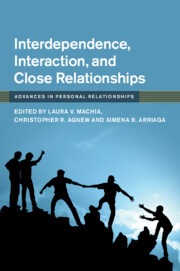Book contents
- Interdependence, Interaction, and Close Relationships
- Advances in Personal Relationships
- Interdependence, Interaction, and Close Relationships
- Copyright page
- Contents
- Figures
- Tables
- Contributors
- Acknowledgments
- Introduction
- Part I Interdependence, Situations, and Context
- Part II Interdependence, Security, and Risk
- Part III Interdependence, Goal Pursuit, and Person Factors
- Part IV Interdependence, Timing, and Expectations
- 13 Relationship Receptivity Theory
- 14 A New Measure of Expected Relationship Satisfaction, Alternatives, and Investment Supports an Expectations Model of Interdependence
- 15 Relationship Expectations about the Commitment to Wed
- 16 Creating Closeness and Interdependence
- Index
- References
16 - Creating Closeness and Interdependence
Results of Laboratory-Based Studies Involving Getting-Acquainted Dyads
from Part IV - Interdependence, Timing, and Expectations
Published online by Cambridge University Press: 19 June 2020
- Interdependence, Interaction, and Close Relationships
- Advances in Personal Relationships
- Interdependence, Interaction, and Close Relationships
- Copyright page
- Contents
- Figures
- Tables
- Contributors
- Acknowledgments
- Introduction
- Part I Interdependence, Situations, and Context
- Part II Interdependence, Security, and Risk
- Part III Interdependence, Goal Pursuit, and Person Factors
- Part IV Interdependence, Timing, and Expectations
- 13 Relationship Receptivity Theory
- 14 A New Measure of Expected Relationship Satisfaction, Alternatives, and Investment Supports an Expectations Model of Interdependence
- 15 Relationship Expectations about the Commitment to Wed
- 16 Creating Closeness and Interdependence
- Index
- References
Summary
Closeness and interdependence are considered to be essential components of any intimate relationship of significant duration.These core processes, however, can also be manifested in one-time interactions between strangers, with positive consequences including an increase in positive mood and belongingness. Many years ago, Art Aron and his colleagues developed a closeness-generating exercise (sometimes referred to as the Fast Friends procedure) that was designed to generate “a temporary feeling of closeness, not an actual ongoing relationship” within pairs of strangers. Other closeness- and interdependence-inducing tasks have also been developed including additional ones based on structured, self-disclosure and some based on doing activities such as playing a game or engaging in humorous activities.In this chapter, I describe the different tasks that have been developed to create a feeling of closeness or interdependence in initial structured interactions, the types of research questions that have been addressed with this method, and sample findings across multiple lines of research. Although there are limits in the degree to which findings from research based on temporary feelings of closeness in a laboratory setting can generalize to initial interactions and developed relationships in the “real world,” creating closeness and interdependence in a laboratory setting allows researchers to test the influence of various theoretically-important variables, including individual characteristics (shyness), the context of the interaction (medium of communication), and mediators (perception of being liked by the other).
Information
- Type
- Chapter
- Information
- Interdependence, Interaction, and Close Relationships , pp. 343 - 367Publisher: Cambridge University PressPrint publication year: 2020
References
Accessibility standard: Unknown
- 2
- Cited by
